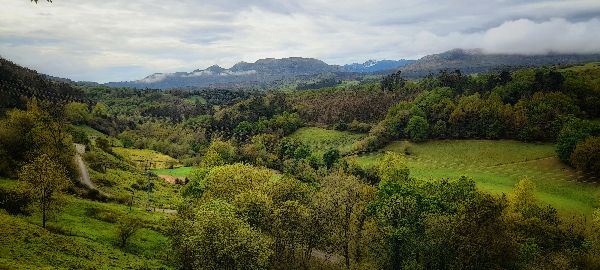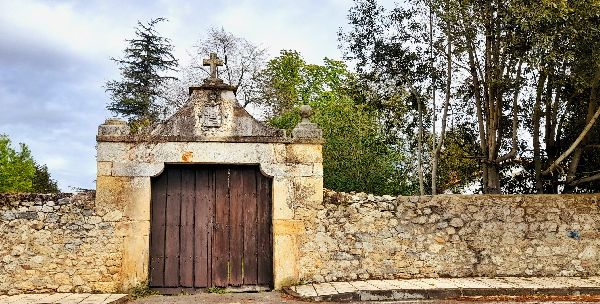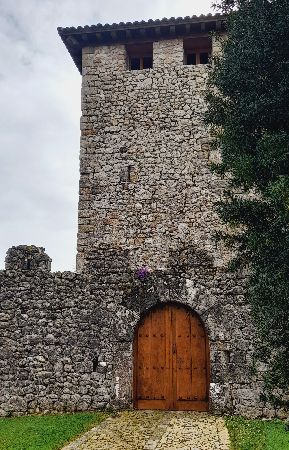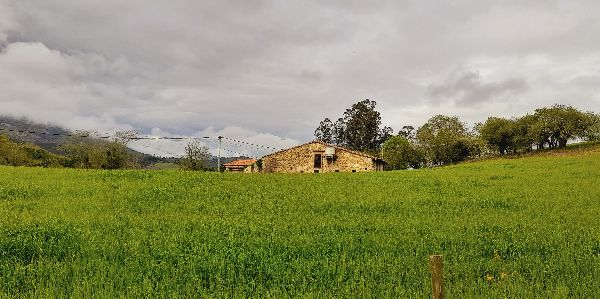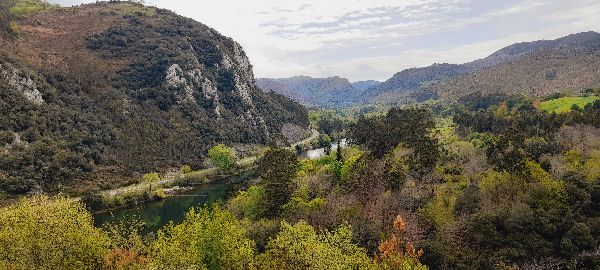Herrerías

 Download the cheat sheet and go!
Download the cheat sheet and go!
|
In the middle of the Camino Lebaniego and at the bank of the Nansa River is the municipality of Herrerías. It’s made up of the villages of Bielva, Cabanzón, Cades, Camijanes, Casamaría, El Collado, Rábago, Otero and Puente El Arrudo. You’ll have the opportunity to experience a wide range of activities in Herrerías, like discovering the underground world of the Soplao cave, learning how an 18th century iron foundry was run or being a pilgrim as you walk along the Nansa River path. The name Herrerías refers to the large number of foundries that there used to be in the municipality. Its shield depicts an anvil and 8 silver horseshoes referencing these primitive iron foundries. Its strategic location was relevant during the Middle Ages; this is proven by the medieval tower in Cabanzón, which we’ll talk about later. In addition to livestock, mining is another economic activity significant to the municipality. Many men worked in what is now considered to be an underground gem: the Soplao cave. The cave was part of the Florida Mining Group from which spahlerite and galena were extracted. Nowadays, the cave has shifted from mining activity to being a tourist attraction. It’s definitely a must-see experience! After giving you a few broad brushstrokes of its history, we’ll reveal more details and interesting facts about the ESSENTIAL things you need to EXPLORE:
In the 18th century a rural complex which consisted of an iron foundry and a gristmill was built next to the Nansa River. Its purpose was to transform iron into ingots and corn grain into flour. Nowadays, the foundry and mill are a museum attraction that can be visited. During the guided tour, you’ll be able to see how a foundry worker and miller lived and worked. You’ll also see a live demonstration of how the force of the water is capable of moving these great hydraulic devices.
The municipalities of Herrerías, Rionansa and Valdáliga share a subterranean world, the El Soplao cave. At the beginning of the 20th century, a group of miners discovered El Soplao while they were looking for zinc. Its geological richness is its greatest attraction. The cave is covered in speleothems like stalactites, stalagmites, flowstones and columns, although the eccentric ones are the most striking and amazing. There are 3 types of tour visits:
It’s not strange to see pilgrims passing through Herrerías; in fact, you may be one of them! That’s because we’re right in the middle of the Camino Lebaniego, one of the first pilgrimage routes with its own credentials. The reason so many people pass through is because they’re trying to reach the Monastery of Santo Toribio de Liébana where the Lignum Crucis—the largest fragment of the True Cross—is located. It’s an Año Jubilar (Holy Year) each time the day of Santo Toribio—April 16th--falls on a Sunday. The Camino passes along the Nansa River path between Puente El Arrudo and Cades. Come experience what it’s like to be a pilgrim for a day!
If you’re keen on walking, then we invite you to come walk along the Nansa River path, which not only used to be the old fishermen’s trail, but also part of the Camino Lebaniego. It passes through the municipalities of Val de San Vicente and Herrerías, between the villages of Muñorrodero and Puente El Arrudo. It’s 13 kilometers which could be separated into two legs: the first from Muñorrodero to Camijanes, and the second from Camijanes to the CA-855 road, between Puente El Arrudo and Otero. The first stretch is recommended for families, while the second one is of moderate difficulty. However, neither of them are suitable for a baby carriage.
1st leg: Muñorrodero – Camijanes In Muñorrodero, in the area of the cabins and cemetery, take the path that leads to the recreational area, which is where you can leave your car. Then you return a few meters on foot to start the route. The trail runs along the banks of the Nansa River and it’s not difficult. In fact, there’s even stairs and walkways in several sections along the trail. However, just be careful if it’s rained heavily because it’s a flood zone. Throughout the hike, you’ll see a forest right along the river, an area for climbing and shelters and walkways that fishermen used to cross the river. At the end of this leg you’ll find the Trascudia power plant, which is where the Supino River reaches the Nansa River in the form of a waterfall.
2nd leg: Caminajes – Puente El Arrudo To start this leg, you should take the detour at Los Collados towards Trascudia. Here, the trail has a greater incline and it’s been preserved in its natural state. After passing Tortorio bridge, you’ll reach the Trascudia hydroelectric power plant, which has been running since 1949. From that point on, you fully enter the path that runs through holm oaks and a riverside forest. You’ll then reach an access area that’s a little more complicated, Peña Sancho, where there’s a cable to help you pass the rocky area. Once you reach the bridge that connects Puente El Arrudo and Otero, you can extend the walk to the Iron Foundry of Cades. Technical information and recommendations: ► Starts and ends: Muñorrodero - Puente El Arrudo Notes: 1. We recommend downloading the track of the route on your phone.
On the CA-181 road near Camijanes, there’s a sign that indicates a lookout point: El Collado. It’s also known as El Poeta (The Poet) lookout point. Next to the parking lot are the access stairs that pass by holm oaks and end up at a terrace that overlooks the Nansa River. The views are incredible: Cabanzón and its meadows, the Arria massif, the sierras of Cocón and El Cuera, Picos de Europa (Peaks of Europe), the peak of Peñamellera and the Trascudia hydroelectric power plant right next to the river. The 180° sights are incredible!
Here are a few more suggestions to complete your visit to Herrerías:
A walk through Bielva is a beautiful display of typical “montañes” architecture and traditions. Apart from the beautiful mountain homes, there are two places with special significance: the bowling alley dedicated to “The Lefty of Bielva” and the Santo Cristo de los Remedios chapel. Bowling is a rural sport that is mostly played in Cantabria. There are different categories of bowling like “bolo pasiego,” “pasabolo” and “bolo palma,” which is the most common. The players form bowling teams that play in different leagues and competitions regulated by the Cántabra Bowling Federation. The key elements are: the bowling alley, the pins, the balls and, of course, the bowlers. In the bowling world, there’s a hugely important figure: Rogelio González “The Lefty of Bielva”. He was born in La Habana, like many children of emigrants. When he was a year old, his family came from Cuba to Bielva and he started bowling at a very young age. He was ahead of his time because, despite not having an athletic figure, he knew how to work his mental strength to perfect his technique, just like elite athletes of today. He’s remembered in Bielva with a commemorative bust next to the bowling alley and a memorial that’s celebrated every year.
The Christ chapel in Bielva is another point of interest to visit. It was built in the 13th century and inside there’s a wooden carving of Christ Crucified. Nearby are the “Stairs of Christ,” 309 stone steps that start from Puente El Arrudo and lead to the Cristo de los Remedios chapel, where those who had made promises to the Christ of Bielva used to climb.
There’s a medieval tower in Cabanzón that belonged to the Rábago estate. It possibly formed part of a defensive line around San Vicente de la Barquera, along with the towers in Estrada, Obeso and those that have already disappeared in Celis and Bielva. It’s one of the few examples of a tower with a defensive wall protecting it. In the 15th century the king ordered it be clipped at the top, meaning that its battlements were destroyed. It was named a Cultural Interest Asset and it’s currently on private property.
Coming from Venta Fresnedo, along the CA-856 road, there’s a balcony that overlooks the municipality of Rionansa: the La Palombera viewpoint. The Camino Lebaniego passes through this site, so it’s possible you may come across pilgrims traveling or resting around here. It’s the perfect spot to view the Palombera reservoir and see where the Tanea and Nansa Rivers converge. Right at your feet, hidden among the vegetation, is Chufín cave, one the gems of the region and World Heritage Site.
|




